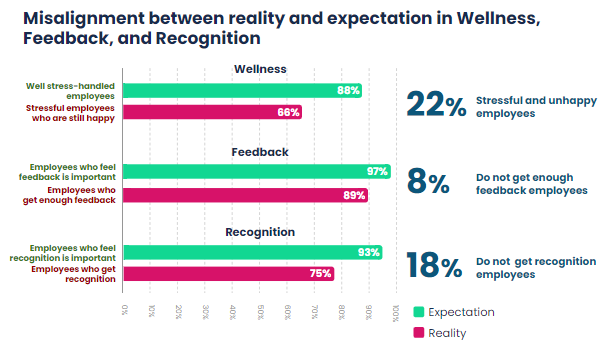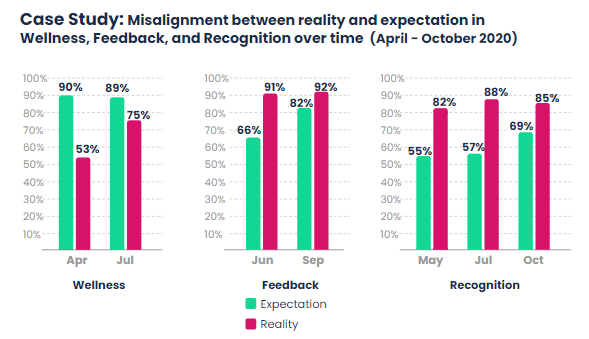Studies show that reducing gaps between employee expectations and reality across key engagement dimensions results in higher employee engagement. A case study shows how gaps can be minimized over time.
The importance of understanding employees
“To win in the marketplace, you must first win in the workplace.” — Doug Conant, former President and CEO of Campbell Soup.
Winning in the workplace is about how organizations engage with and win the hearts of their employees. It begins with understanding employee’s needs and expectations. Managing these expectations is critical to motivating employees and enabling them to perform at their best.
When organizations understand employee needs well, leaders can better serve their needs, and employees are more engaged, resulting in lower turnover rates and higher performance. It is essential to recognize that not all employees are the same: employees will have different needs depending on the levels of consciousness they are operating from [1]. Closing the expectation and reality gap can help managers and leaders extract the best out of their people and lead to a healthy work culture [2].
We studied employees’ expectations and reality for three work-life dimensions: Wellness, Feedback, and Recognition (critical drivers of employee engagement and retention).
Study & Results
Our Hypothesis: “There are gaps between employee expectation and reality for Wellness, Feedback, and Recognition that can be reduced over time.”
Our Study
Pulse survey responses from over 1,500 employees are studied to measure expectations and reality gaps. For Wellness, we looked for a measure of perceived and actual resilience; employees who felt they handle stress well and remained happy during periods of stress.
For Feedback, we measured how vital feedback is to them against how much feedback they receive regularly. Similarly, for Recognition, we measured how important recognition is to them against how regularly they reported to receive recognition from others.
The results showed that:
- Wellness: 88% of employees report being resilient (can be happy during periods of stress), but only 66% measure to be.
- Feedback: 97% of employees report that feedback is critical to them, and 89% get enough feedback.
- Recognition: 93% of employees report that recognition is significant to them, and only 75% regularly receive recognition from others.

Results show that there exist gaps between employees’ expectations and reality. In managing employee expectations, each gap represents an opportunity to fulfill needs and improve employee engagement and performance.
Wellness, feedback, and recognition illustrate that our workplaces experience gaps in the most straightforward engagement dimensions. Gaps in work satisfaction, personal growth, company alignment (and others) play an even more significant role in maximizing potential and subject to future studies.
Case study
Can gaps between expectations and reality be reduced? And what are the business implications?
Daily pulse survey data for Company A’s 210 employees are studied over six months to see how gaps change over time, along with other measurable outcomes.
Comparisons between expectations and reality for wellness, feedback, and recognition are studied at these times:
1. Wellness: data are compared two times in April and July 2020
2. Feedback: data are compared two times in June and September 2020
3. Recognition: data are compared three times in May, July, and October 2020
Results
For wellness, an increase in resilience is observed. A greater number of employees reported being happy during periods of stress, and the gap decreased.
- In April, 90% of employees responded that they handle stress well, while only 53% were happy during periods of stress.
- In July, 89% of employees responded that they handle stress well, and 75% were happy during stress periods.
For feedback, employees who reported getting enough feedback only slightly increased, but the number of employees who report feedback as necessary increased significantly.
- In June, 66% of employees reported that feedback is essential to them, and 91% got enough feedback.
- In September, 82% of employees reported that feedback is essential to them, and 92% got enough feedback.
For recognition, employees who reported getting enough recognition slightly increased, but the number of employees who reported recognition as an important thing increased more significantly.
- In May, 55% of employees reported that recognition is essential to them, and 82% received enough recognition from others.
- In July, 57% of employees reported that recognition is essential to them, and 88% received enough recognition from others.
- In October, 69% of employees reported that recognition is essential to them, and 85% received enough recognition from others.

Findings:
- With the right people development & management practices (see Happily.ai), resilience can be significantly improved within six months — reducing the wellness gap.
- With regular and more timely feedback and recognition, the importance employees place on these activities is significantly increased and reduces the expectation and reality gap.
- Reducing the gap can impact the following engagement outcomes:
3.1 Happy teams: over 75% of employees reported that they are happy.
3.2 Reduced people risks: The number of risk-free teams (no reports of unhappy members in a team) increased by 12%.
3.3 Perception of expectations being met increased: The median score for “On a scale of 0 to 10, how well does our company meet your expectations?” increased from 7 to 8 — a small but significant improvement.
Four ways to better understand your employees
Understanding employees isn’t an easy task. Each employee has different needs, wants, and expectations [3]. To maximize potential (a core responsibility of leaders), these expectations must be well-managed in each step of the employee experience lifecycle.
Adaptive leadership, pulse surveys, and employee feedback that lead to meaningful conversations, and work-style profiling are foundational to help us better understand employees in real-time:
- Adaptive leadership: Employees respond better to leaders who listen and adapt to different needs. There are several kinds of leadership styles, all of which have proven efficacy depending on the circumstances, attitudes, beliefs, preferences, and people involved [4].
- Pulse survey and continuous feedback: Deploying pulse surveys is an excellent way to gather employee feedback in real-time. Be sure to listen and act on feedback received. It is an opportunity to reinforce strengths and improve on organizational weaknesses.
- Communication: Have an open communication line with your employees (not just your management), and encourage managers to have meaningful conversations with their direct reports. Employee feedback should be viewed as conversation starters.
- Work-style profiling: We’re all motivated, process information, and interact with our work/environment differently. A work-style profiling exercise can provide additional insight into our employees and help them collaborate with others better.
Conclusion
The gap between employee expectations and reality exists across many different dimensions of work-life. The right practices and tools can help manage these expectations and reduce gaps to result in more engaged and higher-performing employees. In our efforts to build diversity in our workplaces, we need capabilities to help us better understand our people in a dynamic working environment.
Happily.ai helps organizations understand their employees by providing real-time engagement surveys, facilitating meaningful conversations, providing actionable insights for leaders/managers, work-style profiling, and much more! Please visit us on our website or try our demo here.
References:
[1]https://www.tlnt.com/understanding-employee-needs-key-to-creating-a-highly-motivated-workforce/
[2] https://www.managementstudyguide.com/knowing-your-employees.htm
[4] https://www.infotrack.com.au/news-and-insights/5-powerful-tools-for-better-understanding-employees/
[5] Photo by Mimi Thian on Unsplash









